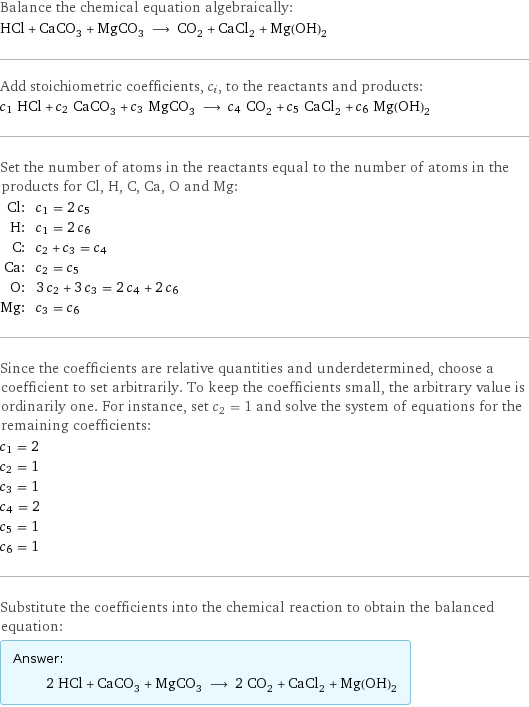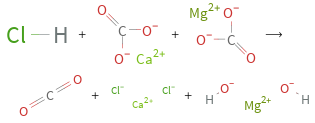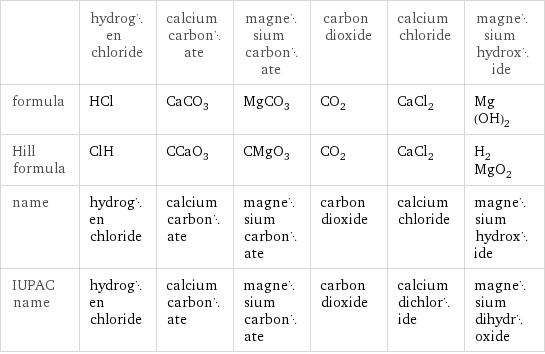Input interpretation

HCl hydrogen chloride + CaCO_3 calcium carbonate + MgCO_3 magnesium carbonate ⟶ CO_2 carbon dioxide + CaCl_2 calcium chloride + Mg(OH)_2 magnesium hydroxide
Balanced equation

Balance the chemical equation algebraically: HCl + CaCO_3 + MgCO_3 ⟶ CO_2 + CaCl_2 + Mg(OH)_2 Add stoichiometric coefficients, c_i, to the reactants and products: c_1 HCl + c_2 CaCO_3 + c_3 MgCO_3 ⟶ c_4 CO_2 + c_5 CaCl_2 + c_6 Mg(OH)_2 Set the number of atoms in the reactants equal to the number of atoms in the products for Cl, H, C, Ca, O and Mg: Cl: | c_1 = 2 c_5 H: | c_1 = 2 c_6 C: | c_2 + c_3 = c_4 Ca: | c_2 = c_5 O: | 3 c_2 + 3 c_3 = 2 c_4 + 2 c_6 Mg: | c_3 = c_6 Since the coefficients are relative quantities and underdetermined, choose a coefficient to set arbitrarily. To keep the coefficients small, the arbitrary value is ordinarily one. For instance, set c_2 = 1 and solve the system of equations for the remaining coefficients: c_1 = 2 c_2 = 1 c_3 = 1 c_4 = 2 c_5 = 1 c_6 = 1 Substitute the coefficients into the chemical reaction to obtain the balanced equation: Answer: | | 2 HCl + CaCO_3 + MgCO_3 ⟶ 2 CO_2 + CaCl_2 + Mg(OH)_2
Structures

+ + ⟶ + +
Names

hydrogen chloride + calcium carbonate + magnesium carbonate ⟶ carbon dioxide + calcium chloride + magnesium hydroxide
Equilibrium constant
![Construct the equilibrium constant, K, expression for: HCl + CaCO_3 + MgCO_3 ⟶ CO_2 + CaCl_2 + Mg(OH)_2 Plan: • Balance the chemical equation. • Determine the stoichiometric numbers. • Assemble the activity expression for each chemical species. • Use the activity expressions to build the equilibrium constant expression. Write the balanced chemical equation: 2 HCl + CaCO_3 + MgCO_3 ⟶ 2 CO_2 + CaCl_2 + Mg(OH)_2 Assign stoichiometric numbers, ν_i, using the stoichiometric coefficients, c_i, from the balanced chemical equation in the following manner: ν_i = -c_i for reactants and ν_i = c_i for products: chemical species | c_i | ν_i HCl | 2 | -2 CaCO_3 | 1 | -1 MgCO_3 | 1 | -1 CO_2 | 2 | 2 CaCl_2 | 1 | 1 Mg(OH)_2 | 1 | 1 Assemble the activity expressions accounting for the state of matter and ν_i: chemical species | c_i | ν_i | activity expression HCl | 2 | -2 | ([HCl])^(-2) CaCO_3 | 1 | -1 | ([CaCO3])^(-1) MgCO_3 | 1 | -1 | ([MgCO3])^(-1) CO_2 | 2 | 2 | ([CO2])^2 CaCl_2 | 1 | 1 | [CaCl2] Mg(OH)_2 | 1 | 1 | [Mg(OH)2] The equilibrium constant symbol in the concentration basis is: K_c Mulitply the activity expressions to arrive at the K_c expression: Answer: | | K_c = ([HCl])^(-2) ([CaCO3])^(-1) ([MgCO3])^(-1) ([CO2])^2 [CaCl2] [Mg(OH)2] = (([CO2])^2 [CaCl2] [Mg(OH)2])/(([HCl])^2 [CaCO3] [MgCO3])](../image_source/7b0595a3ff9a28b68494979b75f5d4c7.png)
Construct the equilibrium constant, K, expression for: HCl + CaCO_3 + MgCO_3 ⟶ CO_2 + CaCl_2 + Mg(OH)_2 Plan: • Balance the chemical equation. • Determine the stoichiometric numbers. • Assemble the activity expression for each chemical species. • Use the activity expressions to build the equilibrium constant expression. Write the balanced chemical equation: 2 HCl + CaCO_3 + MgCO_3 ⟶ 2 CO_2 + CaCl_2 + Mg(OH)_2 Assign stoichiometric numbers, ν_i, using the stoichiometric coefficients, c_i, from the balanced chemical equation in the following manner: ν_i = -c_i for reactants and ν_i = c_i for products: chemical species | c_i | ν_i HCl | 2 | -2 CaCO_3 | 1 | -1 MgCO_3 | 1 | -1 CO_2 | 2 | 2 CaCl_2 | 1 | 1 Mg(OH)_2 | 1 | 1 Assemble the activity expressions accounting for the state of matter and ν_i: chemical species | c_i | ν_i | activity expression HCl | 2 | -2 | ([HCl])^(-2) CaCO_3 | 1 | -1 | ([CaCO3])^(-1) MgCO_3 | 1 | -1 | ([MgCO3])^(-1) CO_2 | 2 | 2 | ([CO2])^2 CaCl_2 | 1 | 1 | [CaCl2] Mg(OH)_2 | 1 | 1 | [Mg(OH)2] The equilibrium constant symbol in the concentration basis is: K_c Mulitply the activity expressions to arrive at the K_c expression: Answer: | | K_c = ([HCl])^(-2) ([CaCO3])^(-1) ([MgCO3])^(-1) ([CO2])^2 [CaCl2] [Mg(OH)2] = (([CO2])^2 [CaCl2] [Mg(OH)2])/(([HCl])^2 [CaCO3] [MgCO3])
Rate of reaction
![Construct the rate of reaction expression for: HCl + CaCO_3 + MgCO_3 ⟶ CO_2 + CaCl_2 + Mg(OH)_2 Plan: • Balance the chemical equation. • Determine the stoichiometric numbers. • Assemble the rate term for each chemical species. • Write the rate of reaction expression. Write the balanced chemical equation: 2 HCl + CaCO_3 + MgCO_3 ⟶ 2 CO_2 + CaCl_2 + Mg(OH)_2 Assign stoichiometric numbers, ν_i, using the stoichiometric coefficients, c_i, from the balanced chemical equation in the following manner: ν_i = -c_i for reactants and ν_i = c_i for products: chemical species | c_i | ν_i HCl | 2 | -2 CaCO_3 | 1 | -1 MgCO_3 | 1 | -1 CO_2 | 2 | 2 CaCl_2 | 1 | 1 Mg(OH)_2 | 1 | 1 The rate term for each chemical species, B_i, is 1/ν_i(Δ[B_i])/(Δt) where [B_i] is the amount concentration and t is time: chemical species | c_i | ν_i | rate term HCl | 2 | -2 | -1/2 (Δ[HCl])/(Δt) CaCO_3 | 1 | -1 | -(Δ[CaCO3])/(Δt) MgCO_3 | 1 | -1 | -(Δ[MgCO3])/(Δt) CO_2 | 2 | 2 | 1/2 (Δ[CO2])/(Δt) CaCl_2 | 1 | 1 | (Δ[CaCl2])/(Δt) Mg(OH)_2 | 1 | 1 | (Δ[Mg(OH)2])/(Δt) (for infinitesimal rate of change, replace Δ with d) Set the rate terms equal to each other to arrive at the rate expression: Answer: | | rate = -1/2 (Δ[HCl])/(Δt) = -(Δ[CaCO3])/(Δt) = -(Δ[MgCO3])/(Δt) = 1/2 (Δ[CO2])/(Δt) = (Δ[CaCl2])/(Δt) = (Δ[Mg(OH)2])/(Δt) (assuming constant volume and no accumulation of intermediates or side products)](../image_source/556b36d01ed51df1eea750463fc8345e.png)
Construct the rate of reaction expression for: HCl + CaCO_3 + MgCO_3 ⟶ CO_2 + CaCl_2 + Mg(OH)_2 Plan: • Balance the chemical equation. • Determine the stoichiometric numbers. • Assemble the rate term for each chemical species. • Write the rate of reaction expression. Write the balanced chemical equation: 2 HCl + CaCO_3 + MgCO_3 ⟶ 2 CO_2 + CaCl_2 + Mg(OH)_2 Assign stoichiometric numbers, ν_i, using the stoichiometric coefficients, c_i, from the balanced chemical equation in the following manner: ν_i = -c_i for reactants and ν_i = c_i for products: chemical species | c_i | ν_i HCl | 2 | -2 CaCO_3 | 1 | -1 MgCO_3 | 1 | -1 CO_2 | 2 | 2 CaCl_2 | 1 | 1 Mg(OH)_2 | 1 | 1 The rate term for each chemical species, B_i, is 1/ν_i(Δ[B_i])/(Δt) where [B_i] is the amount concentration and t is time: chemical species | c_i | ν_i | rate term HCl | 2 | -2 | -1/2 (Δ[HCl])/(Δt) CaCO_3 | 1 | -1 | -(Δ[CaCO3])/(Δt) MgCO_3 | 1 | -1 | -(Δ[MgCO3])/(Δt) CO_2 | 2 | 2 | 1/2 (Δ[CO2])/(Δt) CaCl_2 | 1 | 1 | (Δ[CaCl2])/(Δt) Mg(OH)_2 | 1 | 1 | (Δ[Mg(OH)2])/(Δt) (for infinitesimal rate of change, replace Δ with d) Set the rate terms equal to each other to arrive at the rate expression: Answer: | | rate = -1/2 (Δ[HCl])/(Δt) = -(Δ[CaCO3])/(Δt) = -(Δ[MgCO3])/(Δt) = 1/2 (Δ[CO2])/(Δt) = (Δ[CaCl2])/(Δt) = (Δ[Mg(OH)2])/(Δt) (assuming constant volume and no accumulation of intermediates or side products)
Chemical names and formulas

| hydrogen chloride | calcium carbonate | magnesium carbonate | carbon dioxide | calcium chloride | magnesium hydroxide formula | HCl | CaCO_3 | MgCO_3 | CO_2 | CaCl_2 | Mg(OH)_2 Hill formula | ClH | CCaO_3 | CMgO_3 | CO_2 | CaCl_2 | H_2MgO_2 name | hydrogen chloride | calcium carbonate | magnesium carbonate | carbon dioxide | calcium chloride | magnesium hydroxide IUPAC name | hydrogen chloride | calcium carbonate | magnesium carbonate | carbon dioxide | calcium dichloride | magnesium dihydroxide
Substance properties

| hydrogen chloride | calcium carbonate | magnesium carbonate | carbon dioxide | calcium chloride | magnesium hydroxide molar mass | 36.46 g/mol | 100.09 g/mol | 84.313 g/mol | 44.009 g/mol | 111 g/mol | 58.319 g/mol phase | gas (at STP) | solid (at STP) | | gas (at STP) | solid (at STP) | solid (at STP) melting point | -114.17 °C | 1340 °C | | -56.56 °C (at triple point) | 772 °C | 350 °C boiling point | -85 °C | | | -78.5 °C (at sublimation point) | | density | 0.00149 g/cm^3 (at 25 °C) | 2.71 g/cm^3 | | 0.00184212 g/cm^3 (at 20 °C) | 2.15 g/cm^3 | 2.3446 g/cm^3 solubility in water | miscible | insoluble | | | soluble | insoluble dynamic viscosity | | | | 1.491×10^-5 Pa s (at 25 °C) | | odor | | | | odorless | |
Units
